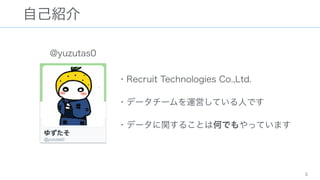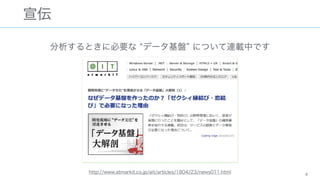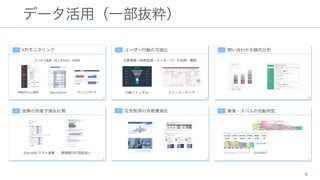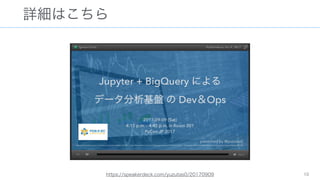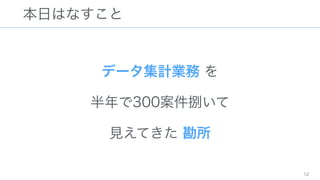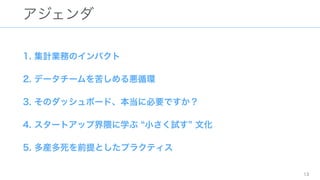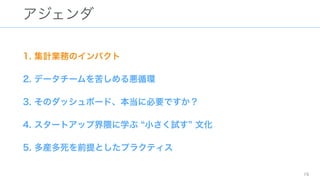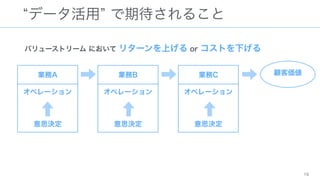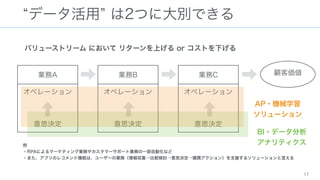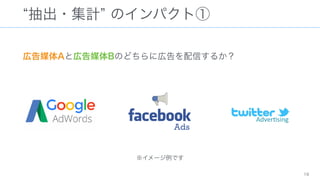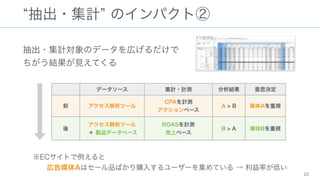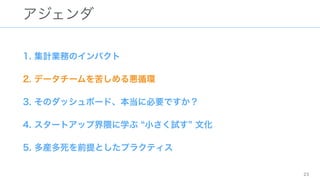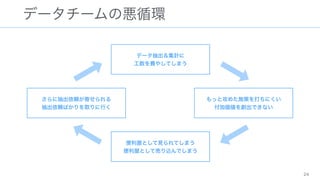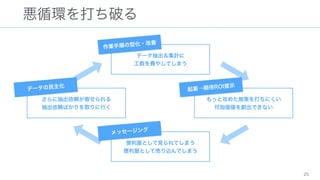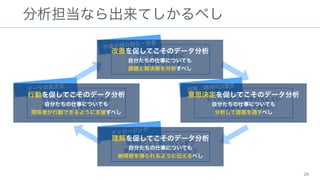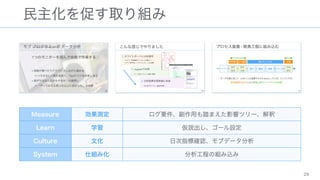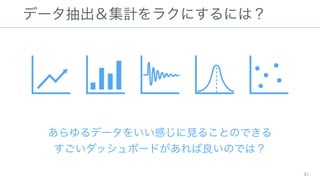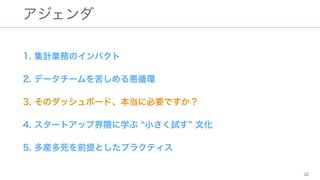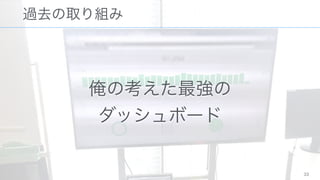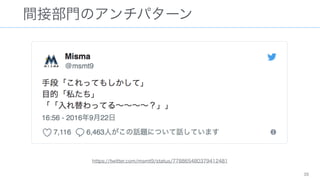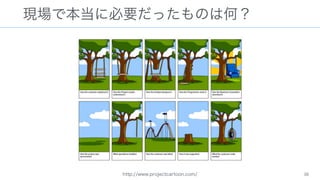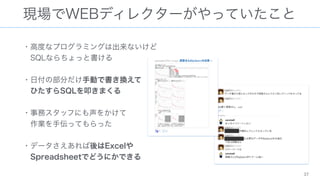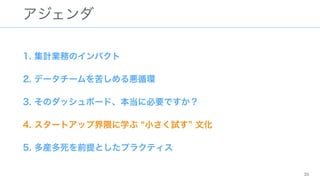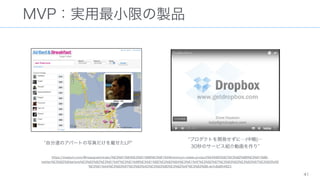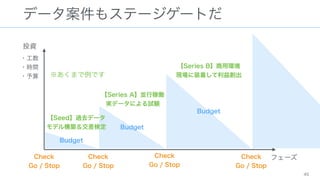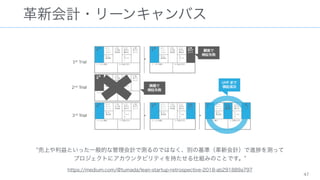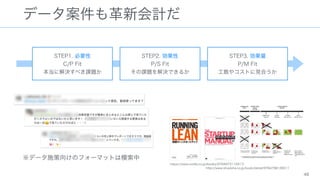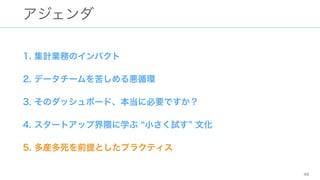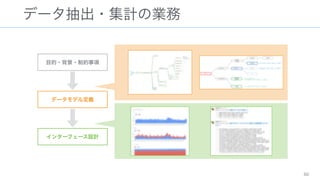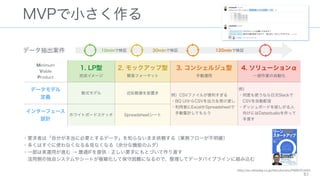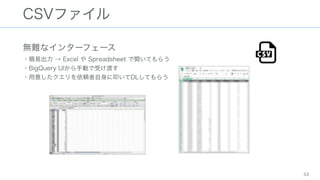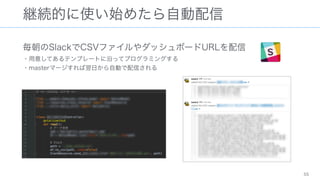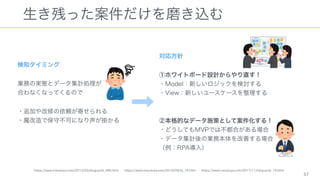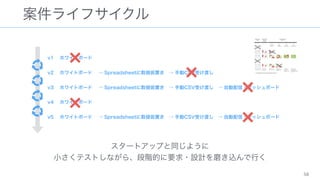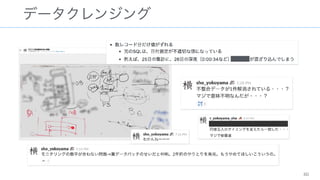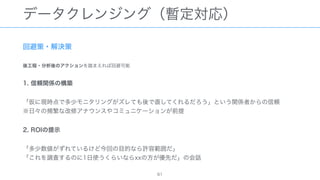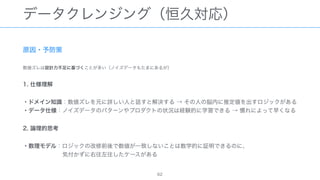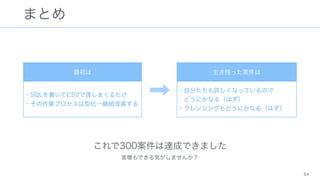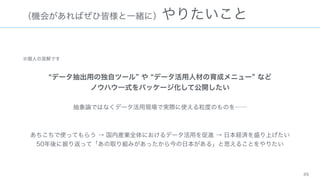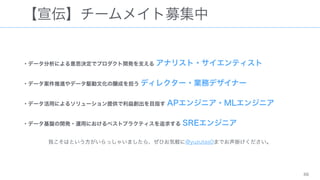データ集計業務を半年で300案件捌いて見えてきた勘所 #データ解析 #willgate
- 1. データ集計業務を? 半年で300案件捌いて? 見えてきた勘所 2018-04-25 データマイニングMeet up #2 presented by @yuzutas0 https://www.pexels.com/photo/person-holding-chart-and-bar-graph-669612/ 1
- 2. はじめに 2
- 6. ※人数やプロジェクトは正確ではありません。ざっくりイメージです。外注?兼任も含みます。 チーム?体制 6 各分野のチーフ Data Scientist, Data Visualization Specialist, Machine Learning Engineer etc… マネジメント マーケティング BI構築 RPA構築 基盤 クレンジング? 品質向上 基盤? SRE改善 経営 BI構築 UX? 分析モデル構築 インタビュー CRE RPA構築 グロースハック 分析支援 Value Value Value Value Value Value Value プロジェクト メンバー 意思決定の支援や? 業務フローの改善 テクニカル面で支援? メンターとして指導 ROI観点で? 優先順位を差配
- 11. 本題 11
- 13. アジェンダ 1. 集計業務のインパクト 2. データチームを苦しめる悪循環 3. そのダッシュボード、本当に必要ですか? 4. スタートアップ界隈に学ぶ 小さく試す 文化 5. 多産多死を前提としたプラクティス 13
- 15. アジェンダ 1. 集計業務のインパクト 2. データチームを苦しめる悪循環 3. そのダッシュボード、本当に必要ですか? 4. スタートアップ界隈に学ぶ 小さく試す 文化 5. 多産多死を前提としたプラクティス 15
- 16. データ活用 で期待されること 16 業務A 業務B 業務C オペレーション オペレーション オペレーション 意思決定 意思決定 意思決定 顧客価値 バリューストリーム において リターンを上げる or コストを下げる
- 17. データ活用 は2つに大別できる 例? ?RPAによるマーケティング業務やカスタマーサポート業務の一部自動化など? ?また、アプリのレコメンド機能は、ユーザーの業務(情報収集→比較検討→意思決定→購買アクション)を支援するソリューションと言える 17 業務A 業務B 業務C オペレーション オペレーション オペレーション 意思決定 意思決定 意思決定 顧客価値 BI?データ分析? アナリティクス AP?機械学習? ソリューション バリューストリーム において リターンを上げる or コストを下げる
- 18. 基盤の次は データ抽出?集計 フェーズ 18 まだ計測できないものが多い 勘による意思決定 データ基盤への一元化 根拠のある意思決定 業務フローの磨き込み データ抽出の要望が増える 世に言うデータ活用の本格化 例)先行指標を特定するための高度な分析 例)RPAによる意思決定?作業の自動化 データ基盤の必要性 1 2 3 基盤 BI(初級編) サイエンス?機械学習
- 20. 抽出?集計 のインパクト② 抽出?集計対象のデータを広げるだけで? ちがう結果が見えてくる 20 データソース 集計?計測 分析結果 意思決定 前 アクセス解析ツール CPAを計測? アクションベース A > B 媒体Aを重視 後 アクセス解析ツール + 製品データベース ROASを計測 売上ベース B > A 媒体Bを重視 ※ECサイトで例えると? ??広告媒体Aはセール品ばかり購入するユーザーを集めている → 利益率が低い
- 21. データを見る → 行動が変わる → 結果が変わる データを繋げて可視化するだけで? ビジネス改善のインサイトを得られる(こともある) 抽出?集計 のインパクト③ 21 ※あくまでも一般的な話です 広告単価あたりの売上 集客に掛ける金額 → 改善インパクト ? 大 ? 大
- 23. アジェンダ 1. 集計業務のインパクト 2. データチームを苦しめる悪循環 3. そのダッシュボード、本当に必要ですか? 4. スタートアップ界隈に学ぶ 小さく試す 文化 5. 多産多死を前提としたプラクティス 23
- 28. チームごとの民主化状況 各チームがデータ活用できているかモニタリング → ブロッカーの検知?分析 → 改善アクション 28 チームA チームB チームC チームD チームE チームF チームG チームH チームI チームJ チームK 生ログ? 独自利用 データT支援? 業務依頼 データT支援? データ出力 自主的? データ出力 担当者依存 担当者依存 担当者依存 自主的? データ生成 他チーム依頼 基盤貢献! 担当者依存 担当者依存 局所化の壁 自走の壁 改善の壁
- 29. 民主化を促す取り組み 29 Measure 効果測定 ログ要件、副作用も踏まえた影響ツリー、解釈 Learn 学習 仮説出し、ゴール設定 Culture 文化 日次指標確認、モブデータ分析 System 仕組み化 分析工程の組み込み
- 32. アジェンダ 1. 集計業務のインパクト 2. データチームを苦しめる悪循環 3. そのダッシュボード、本当に必要ですか? 4. スタートアップ界隈に学ぶ 小さく試す 文化 5. 多産多死を前提としたプラクティス 32
- 39. アジェンダ 1. 集計業務のインパクト 2. データチームを苦しめる悪循環 3. そのダッシュボード、本当に必要ですか? 4. スタートアップ界隈に学ぶ 小さく試す 文化 5. 多産多死を前提としたプラクティス 39
- 42. データ案件もMVPだ 42
- 45. データ案件もステージゲートだ 投資? ????※あくまで例です? フェーズ 45 ?工数? ?時間? ?予算 Check? Go / Stop Budget Budget Budget 【Seed】過去データ? モデル構築&交差検定 【Series A】並行稼働? 実データによる試験 【Series B】商用環境? 現場に装着して利益創出 Check? Go / Stop Check? Go / Stop Check? Go / Stop
- 48. データ案件も革新会計だ ※データ施策向けのフォーマットは模索中 48 STEP2. 効果性? P/S Fit その課題を解決できるか STEP3. 効果量? P/M Fit 工数やコストに見合うか STEP1. 必要性? C/P Fit 本当に解決すべき課題か https://www.oreilly.co.jp/books/9784873115917/ http://www.shoeisha.co.jp/book/detail/9784798128511
- 49. アジェンダ 1. 集計業務のインパクト 2. データチームを苦しめる悪循環 3. そのダッシュボード、本当に必要ですか? 4. スタートアップ界隈に学ぶ 小さく試す 文化 5. 多産多死を前提としたプラクティス 49
- 51. MVPで小さく作る ? ?要求者は「自分が本当に必要とするデータ」を知らないまま依頼する(業務フローが不明確)? ?多くはすぐに使わなくなる&見なくなる(余分な機能のムダ)? ?一部は実運用が進む → 最適IFを提供:正しい要求にもとづいて作り直す? ?活用側の独自システムやシートが複雑化して保守困難になるので、整理してデータパイプラインに組み込む 51 Minimum? Viable? Product 1. LP型? 完成イメージ 2. モックアップ型 簡易フォーマット 3. コンシェルジュ型 手動運用 4. ソリューションα? 一部作業の自動化 データモデル? 定義 数式モデル 近似数値を仮置き 例)CSVファイルが便利すぎる? ?BQ UIからCSVを出力&受け渡し? ?利用者にExcelかSpreadsheetで? ?手動集計してもらう 例)? ?何度も使うなら日次Slackで? ?CSVを自動配信? ?ダッシュボードを欲しがる人? ?向けにはDatastudioを作って? ?手渡す インターフェース? 設計 ホワイトボードスケッチ Spreadsheetシート 10minで検証 30minで検証 120minで検証データ抽出案件 http://ec.nikkeibp.co.jp/item/books/P48970.html
- 52. モックアップ ?????????????ホワイトボードやSpreadsheetで ???????????????推定される概算値を仮置きして? ???????????????出力シートをスケッチして ?????????????集計?抽出後のユースケースをロールプレイ 52 もしこういう値だったら データを出しても ?どういう意思決定になるのか? → ?アクションが変わらなければ ?どのくらいのインパクトがあるのか? → ?工数に効果が見合わなければ を最初に検証する やる意味がない
- 53. CSVファイル 無難なインターフェース? ?簡易出力 → Excel や Spreadsheet で開いてもらう? ?BigQuery UIから手動で受け渡す? ?用意したクエリを依頼者自身に叩いてDLしてもらう? 53
- 54. Data Studio 即席のダッシュボード? ?簡易作成 → 好きに使ってもらう? ?まだ自由度は高くないが簡易モニタリングなら問題なく使える 54
- 58. スタートアップと同じように? 小さくテストしながら、段階的に要求?設計を磨き込んで行く 案件ライフサイクル 58 v1 ホワイトボード v2 ホワイトボード → Spreadsheetに数値仮置き → 手動CSV受け渡し v3 ホワイトボード → Spreadsheetに数値仮置き → 手動CSV受け渡し → 自動配信?ダッシュボード v4 ホワイトボード v5 ホワイトボード → Spreadsheetに数値仮置き → 手動CSV受け渡し → 自動配信?ダッシュボード
- 60. データクレンジング 60
- 62. データクレンジング(恒久対応) 原因?予防策 数値ズレは設計力不足に基づくことが多い(ノイズデータもたまにあるが) 1. 仕様理解 ?ドメイン知識:数値ズレを元に詳しい人と話すと解決する → その人の脳内に推定値を出すロジックがある? ?データ仕様:ノイズデータのパターンやプロダクトの状況は経験的に学習できる → 慣れによって早くなる 2. 論理的思考 ?数理モデル:ロジックの改修前後で数値が一致しないことは数学的に証明できるのに、? ???????気付かずに右往左往したケースがある 62
- 63. 最後に 63
- 65. (機会があればぜひ皆様と一緒に)やりたいこと ※個人の見解です データ抽出用の独自ツール や データ活用人材の育成メニュー など? ノウハウ一式をパッケージ化して公開したい 抽象論ではなくデータ活用現場で実際に使える粒度のものを…… ? あちこちで使ってもらう → 国内産業全体におけるデータ活用を促進 → 日本経済を盛り上げたい? 50年後に振り返って「あの取り組みがあったから今の日本がある」と思えることをやりたい 65
- 66. 【宣伝】チームメイト募集中 ?データ分析による意思決定でプロダクト開発を支える アナリスト?サイエンティスト ?データ案件推進やデータ駆動文化の醸成を担う ディレクター?業務デザイナー ?データ活用によるソリューション提供で利益創出を目指す APエンジニア?MLエンジニア ?データ基盤の開発?運用におけるベストプラクティスを追求する SREエンジニア 我こそはという方がいらっしゃいましたら、ぜひお気軽に@yuzutas0までお声掛けください。 66



